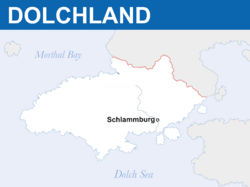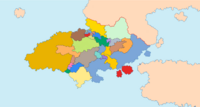Dolchland
This article is incomplete because it is pending further input from participants, or it is a work-in-progress by one author. Please comment on this article's talk page to share your input, comments and questions. Note: To contribute to this article, you may need to seek help from the author(s) of this page. |
Empire of Dolchland Dolchland | |
|---|---|
 Map of Dolchland | |
| Capital | Schlammburg |
| Largest city | Morthal |
| Official languages | Alemannisch |
| Government | Elective Monarchy |
• Emperor | Heinrich Johannes von Fleischmann |
| Legislature | Imperial Diet |
| Diet of Electors | |
| Establishment | |
• Establishment of the Empire | 1777 |
| Population | |
• 2018 estimate | 29,283,179 |
| GDP (nominal) | 2018 estimate |
• Total | $289,991,321,637 |
• Per capita | $9,903 |
| HDI | .600 medium |
| Currency | Thaler |
Dolchland is a country located in South East Argis. Its closest neighbours are Seylos and Ceris to the south, Velaheria to the north, Stedoria to the north-west, and Delamaria and Fravina to the north-east. The capital of Dolchland is Schlammburg, however the largest city is Morthal. The nation has a population of 28 Million, divided among its 40 constituent states. With varying degrees of power and importance, Dolchland's constituent states are fairly independent, with only a common Emperor, external foreign policy and law to unite them. Individual states usually maintain their own militaries and are almost all hereditary monarchies.
Dolchland has declined in recent decades, with a low gdp per capita, and widespread inequality between the ruling aristocracy and the common people. There have been several attempted revolutions in Dolchland's history, however most have been put down with force. Democratic parties are present in most states of the empire, however they are banned in some regions, and where they are allowed they are subject to constant raids and abuse by the local governments.
Etymology
(WIP. German for 'Daggerland'.)
Geography
(WIP. Climate. Environment.)
The country's geography is vast and varied, with some areas being extremely mountainous, others being noxious bogs, and others being old forests from before the time of man. Of note, only the southern parts of the country have somewhat mild summers and winters. The rest of the country tends towards mild summers and harsh winters, with snowfall and thick freezing fog being a constant issue for much of the year. Due to its geographical location, much of the Æitiastain region suffers from thick rolling fog, near constant rain, and thunderstorms during the fall wet season. This is caused by warm and wet air being forced above cooler air by storm systems coming off of the Adlantic. The resulting pressure and potential differentials lead to electrostatic discharges being rather common for the season and cool air filled with moisture condensing near the ground.
Special note should be given to the mountain range in the north of the country. The Apf Kadirn-Gebirge are truly massive, with the largest mountain in the world, Jokultitbjarg, rising in them. They are of quite a large amount of historical importance, as wars have been won and lost over the control of passages through them.
History
Rhodellia
In the 16th century, the then Dolch Empire began colonization efforts in Aurelia, hoping to exploit new lands for their continued growth. The primary resource that the olch were after were gold reserves that the native Aurelian civilizations appeared to have an abundance of. However these colonies ran into significant issues as the native populations were hostile to the Dolch presence in the region. The Dolch followed their initial colonization with a series of local conquests which expanded the reach of the Rhodellian colonies. However by the 18th century, the empire deemed the colonies as too expensive too mantain and allowed a vote for independece resulting in the creation of the Kingdom of Rhodellia.
Stedoria
The Stedorian people come from Dolchic peoples who migrated from where modern day Dolchland currently exists. Eventually this land came under the loose control of the Dolch Empire but in 1568, the Kelvön dynasty formally broke from the empire creating an independent Stedoria.
Volta
In 1641 the Dolch Empire would attempt a second colony in Aurelia where modern day Volta is located. Its first colonization attempt was met with resistence by the Crescent Empire, which ended in the total destruction of the colony. In 1677, Wolter von Ehinger, a Dolch noble, founded the first successful Dolch colony in the area. From the new colony of Köstritz, the Dolch would begin expansion using both Imperial forces and mercenaries. However by 1810, the Volta colony was taken by another power, and by 1875 Volta gained its independence.
Walneria
Walneria was originally inhabited by Slavic peoples from south-central Argis However in the 12th century, Dolchic peoples from the empire began a migration to where modern Walneria is in a movement known as the "Westsiedlung". While Walneria was never integrated into the Empire, this policy of settlement and cultural exposure resulted in a society being mainly Dolch in culture though not fully in ethnicity. Eventually the now Dolch ruling groups in the region came together to form the Kingdom of Walneria.
Ahrana
Ahrana has a history of trade and royal relations with Dolchland. In recent times a former Ahranian Noble married into the Imperial family and became consort of the Emperor.
Seylos
Seylos has had a long history of conflict with Dolchland. Dolch pirates have existed in the waters around Seylos and Ceris for centuries leading in the past to frequent naval engagements. The island of Ceris had also brought much conflict as well, since both were attempting to gain favor with or possibly extend their territory into the island. In the west Dolchic settlers spread forth and from the east, peoples from Seylos did the same. Conflict was common in Ceris until the unification of most of the island under the Hodrean Kingdom, which remained lukewarm at best with Seylos and hostile with Dolchland.
Politics
(WIP. Government. Law. Military. Foreign Relations.)
Dolchland is an elective monarchy, meaning that when the reigning emperor dies, the Diet of Electors is called to elect a new head of state. The members of the Diet are the monarchs and leaders of Dolchland's constituent states, each with varying amounts of votes in the election depending on the size and power of their domain. The current Emperor is His Imperial Majesty, Heinrich Johannes von Fleischmann, the brother of the King of Habstria and nephew of the previous emperor Friedrich Johannes von Fleischmann. The Ausburg-Fleischmann Dynasty has ruled for $Years years, projecting Habstrian power across the empire, however other kingdoms have become increasingly aligned with one another, especially Panedonia, threatening the power of the Habstrian kings over the Imperial throne.
The empire consists of 5 Kingdoms, 13 Duchies, Landgravites and Electorates and 9 Baronies.
Economy
(Energy. Industry. Infrastructure. Transport.)
Demographics
(WIP. Language: Alemannisch. Education. Religion.)
Culture
(Music and Art. Cuisine. Sports.)
Cuisine
Historically, a staple part of the Dolchlander diet was müd, a thick rye and beetroot soup or stew. It was eaten by almost all the strata of Dolchlander society, from the lower classes and to even the aristocracy. Although often considered bland and having something of an earthy flavour, it often had various meats and other vegetables added, depending on season or availability. It has been replaced by other starches, such as the potato, in more recent years, but it remains a key part of Dolchlander identity, one that spreads across all the states of the country. There are several regional variations, such as the schollemüd, made with fried and shredded fillets of Dolchic plaice and eaten in eastern Panedonia or hügelmüd, a variety made with smoked cheese and typically eaten in the hilly north of Wuveria. Similar variations, referred to as käsemüd are found across the upland regions of the country. However, the basic recipe remains the same across Dolchland.
It is thought that the soup inspired the pejorative term for Dolchlanders, "mud-" or "dirt-eater". Foreigners to the country would see the locals tucking into bowls of thick, brown soup and see a likeness to the thick, brown mud of the fertile lands of Dolchland. It is a term that is generally used to portray the Dolchlanders as an ignorant, backward people. This flies in the face of the history as a land of explorers and settlers, although it has been suggested that one of the reasons that they spread so far was to find better things to eat.



